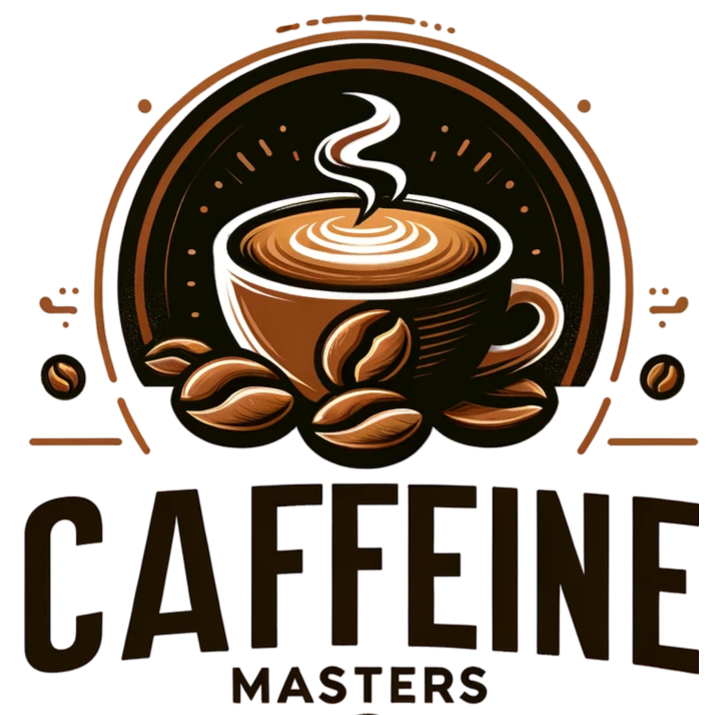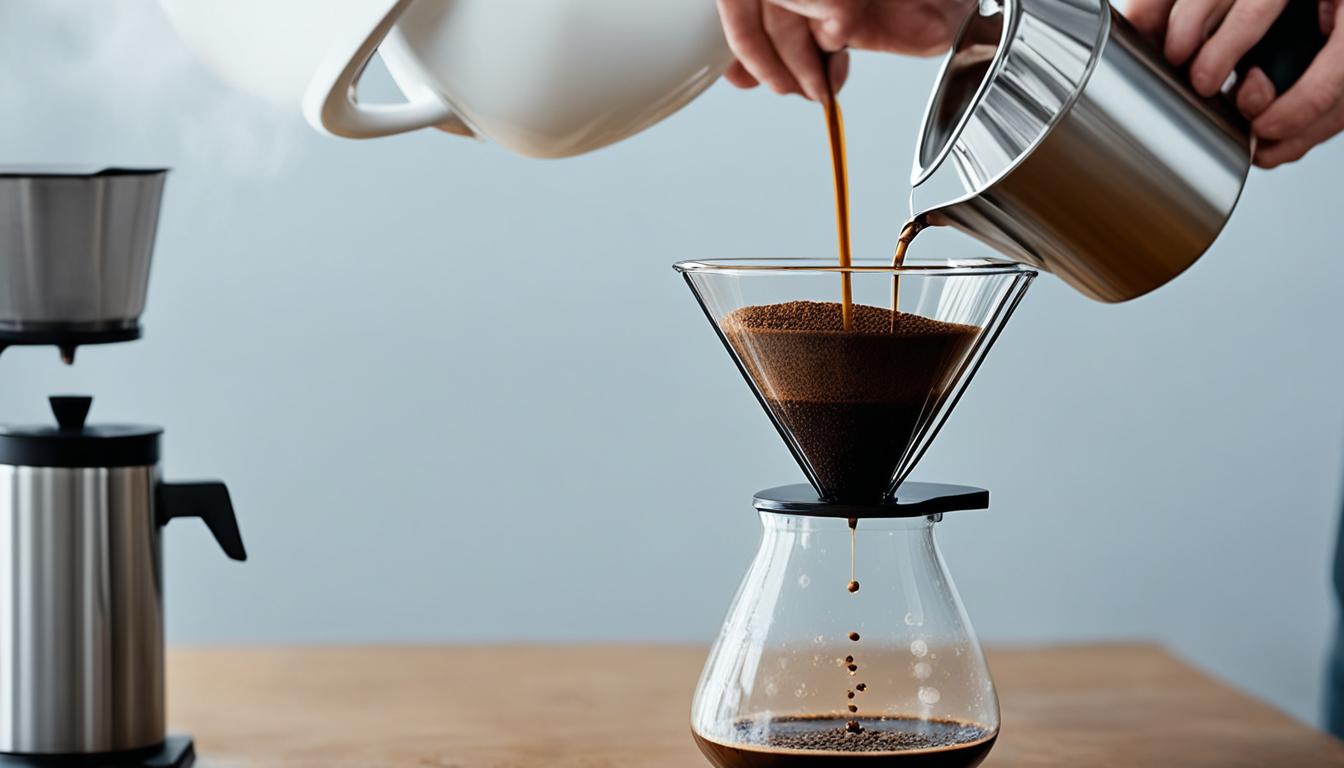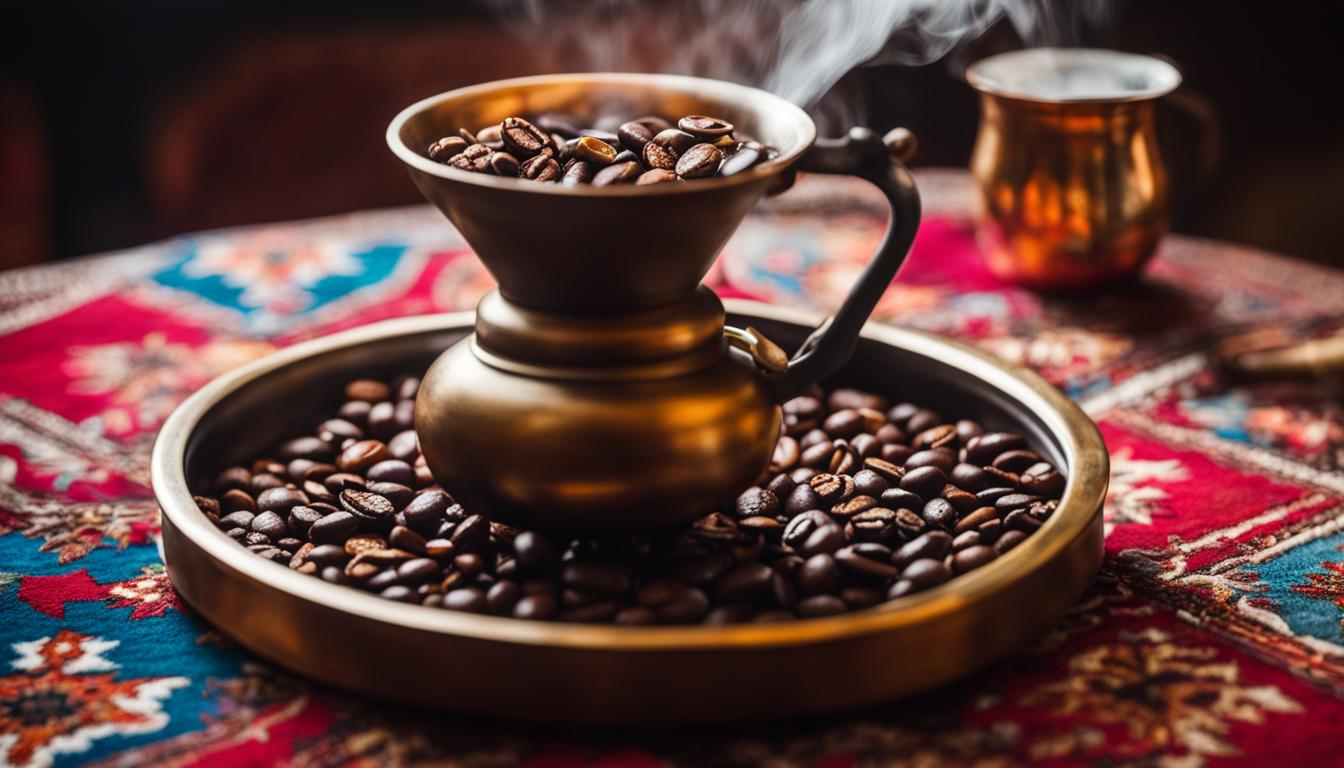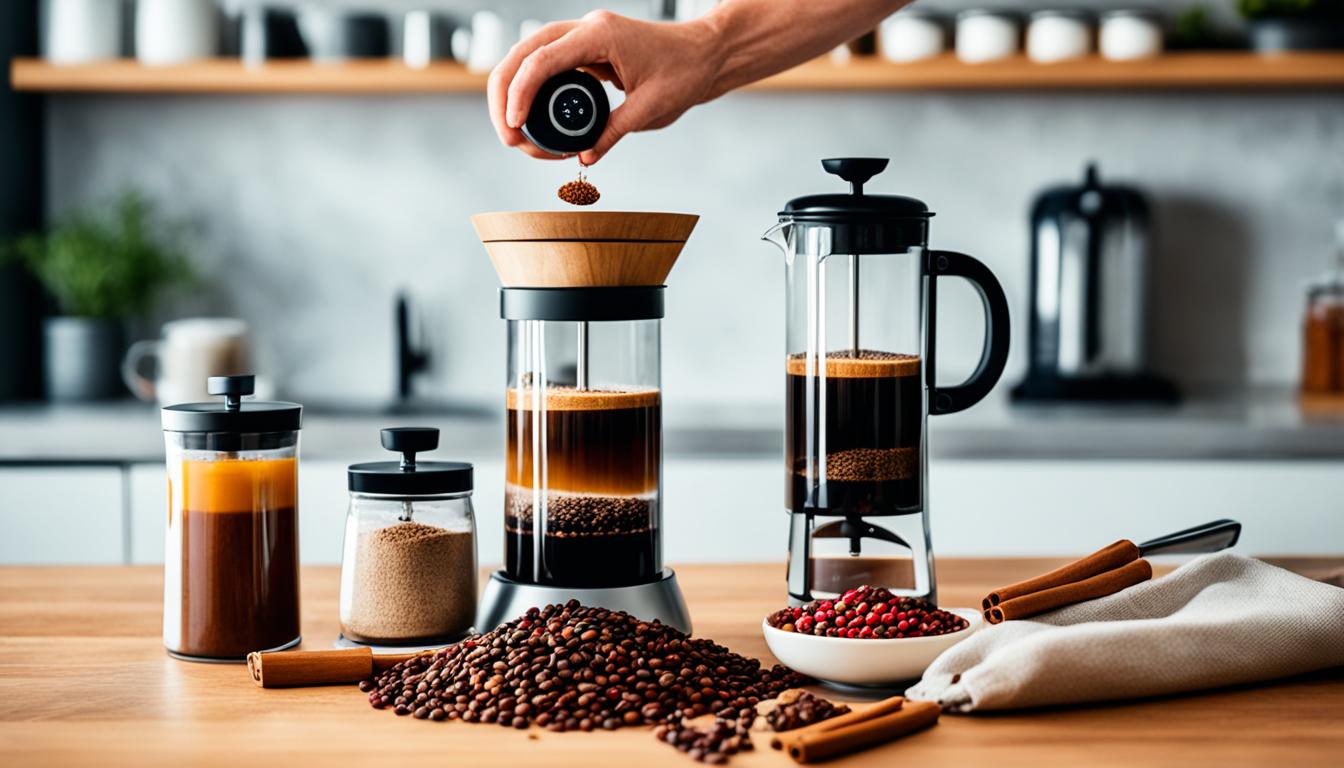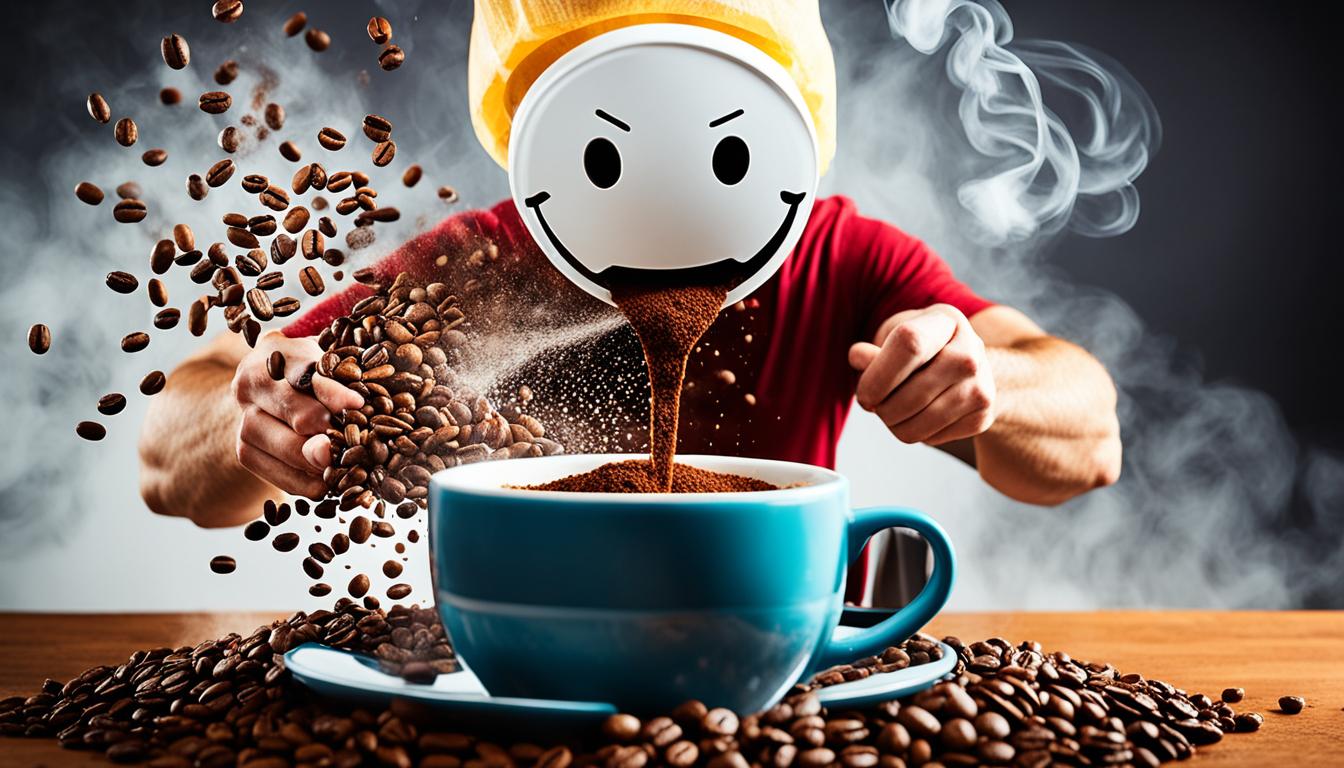Pour over coffee is a beloved brewing method that has been enjoyed by coffee enthusiasts for decades. If you’re looking to elevate your coffee brewing experience, mastering the pour over technique is essential. In this guide, we’ll share valuable tips and insights to help you perfect your pour over coffee and create a flavorful cup every time.
Key Takeaways:
- Use fresh coffee beans and adjust the grind and proportions to your taste.
- Rinse your filter before brewing to remove any paper residue.
- Grind your coffee right before brewing and ensure the correct grind size for your pour over method.
- Master the pouring technique by pouring in slow, steady spirals and using a gooseneck kettle for precision.
- Pay attention to the quality and temperature of the water used in your pour over brew.
The Importance of Grind and Proportions
When it comes to pour over coffee, nothing beats the taste of freshly ground beans. Grinding your coffee right before brewing is essential for achieving optimal flavor and freshness. As soon as coffee is exposed to air, it starts to lose its flavor, so grinding it just before brewing is highly recommended.
The size of your grind particles also plays a crucial role in the extraction process. Different pour over methods require different grind sizes to achieve the best results. Here’s a general guide to help you match the grind size with your pour over method:
Pour Over Method:
- Aeropress: Medium-fine grind
- Chemex: Medium-coarse grind
- Hario V60: Medium-fine grind
- Kalita Wave: Medium grind
By adjusting the grind size to match your pour over method, you can enhance the extraction and achieve a more balanced and flavorful brew.
In addition to grind, proportions are equally important when brewing pour over coffee. To ensure consistency, a general rule of thumb is to use a 1:17 coffee to water weight ratio. For example, if you’re using 30 grams of coffee, you’ll need 510 grams of water. However, feel free to adjust this ratio according to your preference for a stronger or milder cup of coffee.
Now that we understand the importance of grind and proportions, let’s move on to the pouring technique in the next section.
The Pouring Technique
The pouring technique is essential for achieving the best pour over coffee. By mastering this technique, you can enhance the flavor and balance of your brew. Follow these pour over coffee tips for a perfect cup every time:
- Pour Slowly in Steady Spirals: When pouring water over the coffee grounds, make sure to pour slowly in steady spirals. This technique ensures even saturation of the grounds and promotes thorough extraction of flavors.
- Use a Gooseneck Kettle: A gooseneck kettle provides more precision and control over your pouring technique. The long and narrow spout allows you to pour water with greater accuracy, preventing splashing and ensuring an even distribution of water.
- Gentle Stir: During the first pour, known as the bloom pour, gently stir the water and coffee grounds. This helps release the trapped carbon dioxide gas and allows for better saturation, resulting in a more flavorful cup of coffee.
- Pour Slowly and Evenly: Throughout the brewing process, pour the water slowly and evenly. This helps maintain consistent extraction, preventing over or under-extraction of flavors. Avoid pouring too quickly, as it can lead to uneven saturation and a subpar brew.
By following these pour over coffee tips and mastering the pouring technique, you can unlock the full potential of your pour over brewing method. Now let’s explore the importance of water quality and temperature in the next section.
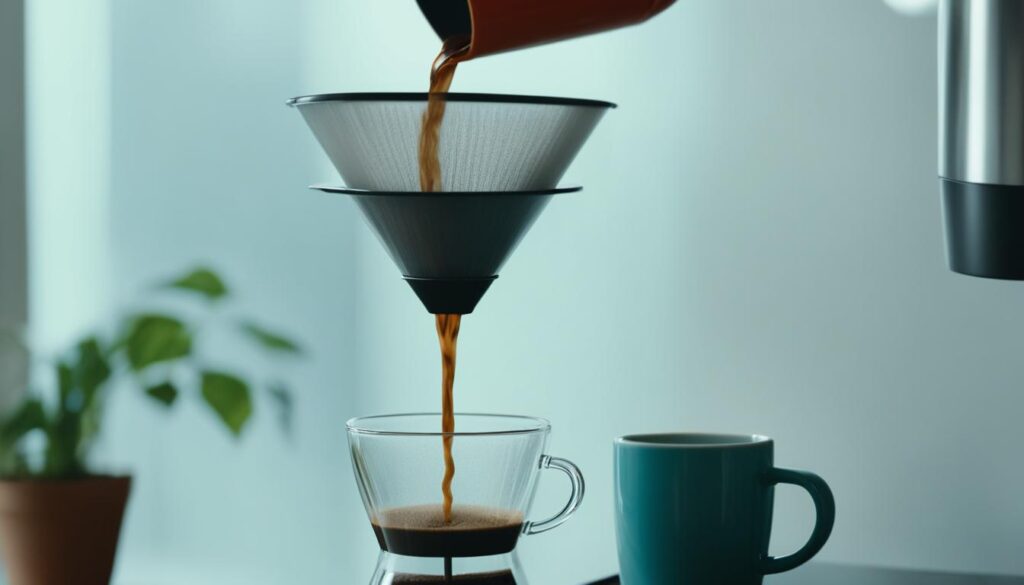
| Pouring Technique | Advantages | Disadvantages |
|---|---|---|
| Slow, Steady Spirals |
|
|
| Gooseneck Kettle |
|
|
| Gentle Stir |
|
|
| Slow and Even Pour |
|
|
Water Quality and Temperature
In the world of pour over coffee, the quality and temperature of the water we use are vital factors that significantly impact the taste of our final brew. It’s essential to choose clean water that you would gladly drink as the foundation of your pour over masterpiece.
When it comes to water temperature, aiming for around 205 degrees Fahrenheit or approximately 30 seconds off the boil is considered ideal for pour over brewing. This temperature helps achieve the perfect balance, extracting the flavors from the coffee grounds without leading to over-extraction or bitterness. Remember, using water that is too hot may result in a harsh and unpleasant taste.
“Using water that is too hot can result in over-extraction and bitterness.”
Conversely, using water that is too cold may lead to under-extraction and weak flavors. It’s a delicate balance that we must strive to achieve, as it helps unlock the aromas and characteristics of the coffee beans.
With every cup of pour over coffee, we have the opportunity to create a unique flavor profile that suits our individual preferences. By finding the right water temperature and ensuring its quality, we can enhance our pour over experience and enjoy the best possible version of our favorite coffee.
The Magic of Water
Water is not just a mere ingredient in our pour over coffee recipe; it’s a magical element that brings out the flavors and nuances locked within the coffee beans. When heated to the right temperature, water acts as a catalyst, initiating the extraction process that transforms our coffee into a delightful elixir.
“Water is not just a mere ingredient in our pour over coffee recipe; it’s a magical element that brings out the flavors and nuances locked within the coffee beans.”
Whether we choose to use filtered water, spring water, or tap water, it’s crucial to consider its quality. Using clean water free from impurities will ensure a pure and unadulterated pour over coffee experience.
Optimizing the Water Temperature
While 205 degrees Fahrenheit is often considered the sweet spot for water temperature in pour over brewing, it’s important to experiment and adjust according to our personal preferences. Some may find that a slightly lower or higher temperature produces a more enjoyable cup of coffee.
Remember, the water temperature is best measured with a reliable thermometer, allowing us to maintain consistency and accuracy throughout our brewing process.
“Remember, the water temperature is best measured with a reliable thermometer, allowing us to maintain consistency and accuracy throughout our brewing process.”
| Water Quality and Temperature | Impact on Pour Over Coffee |
|---|---|
| Clean water | Ensures a pure and unadulterated pour over experience. |
| 205°F or 30 seconds off the boil | Ideal temperature for achieving balanced extraction without over-extraction or bitterness. |
| Water too hot | May result in over-extraction and a harsh taste. |
| Water too cold | May lead to under-extraction and weak flavors. |
By being mindful of the water quality and temperature we use in our pour over brewing, we can unlock the full potential of our coffee beans and create cups of coffee that are a true reflection of our palate.
The Importance of the Bloom
In the world of pour over coffee, the bloom is a critical step that sets the foundation for a well-balanced and flavorful cup of joe. The bloom pour is the first pour in the pour over process, and it plays a vital role in achieving optimal flavors.
During the bloom pour, you’ll saturate the coffee grounds with water. This step promotes even extraction and ensures that every particle of coffee receives the attention it deserves. To create the bloom, pour about twice the amount of water as the coffee grounds and gently stir. This gentle agitation helps release the carbon dioxide gas trapped in the grounds, allowing for better saturation and flavor extraction.
The bloom pour typically takes between 30-45 seconds, but the exact timing may vary depending on factors such as coffee freshness and grind size. Use this time to watch as the coffee bed swells and bubbles emerge, indicating that the extraction process has begun.
“The bloom pour is crucial for achieving optimal flavors in your pour over coffee.”
By giving attention to the bloom pour, you’re optimizing the extraction process and ensuring that the flavors are evenly distributed throughout your brew. This step is particularly important when comparing pour over coffee to other brewing methods like drip coffee, as it allows for more control and precision in flavor extraction.
So remember, the next time you’re brewing pour over coffee, pay close attention to the bloom. It’s the first sign of great flavors to come.
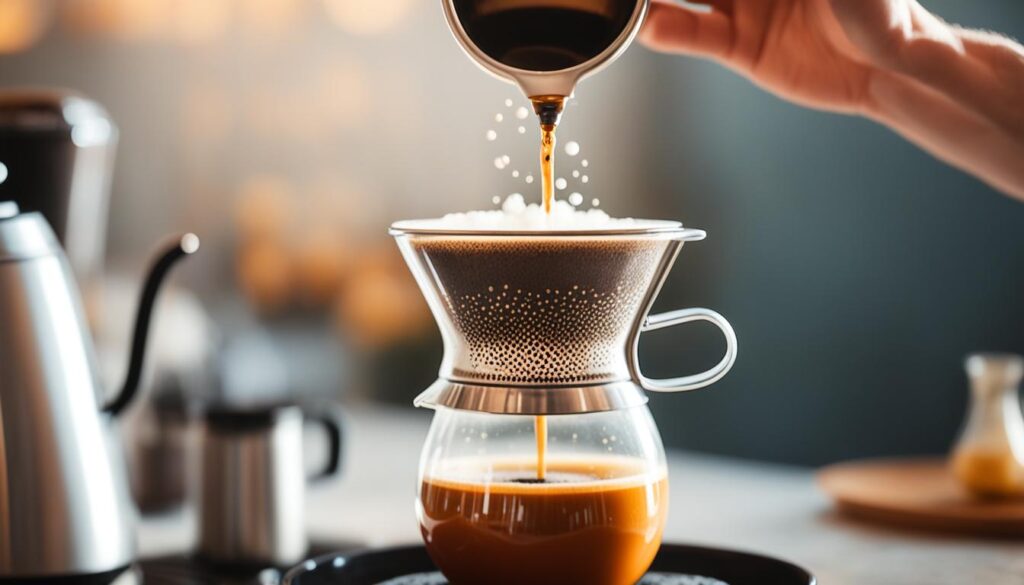
| Pour Over Coffee | Drip Coffee |
|---|---|
| Allows for more precise control over flavor extraction | Less control over extraction process |
| Enhances the flavors and nuances of coffee | Can result in a more generic taste |
| Requires more manual effort and attention | Easier and less involved brewing process |
| Creates a more personalized and customizable cup of coffee | Produces a consistent cup of coffee |
Optimizing the Ratio
The ratio of coffee to water is a crucial element in achieving the perfect pour over brew. By using a consistent water to coffee ratio and making adjustments based on taste, you can fine-tune your coffee’s flavor profile to suit your preferences.
As a general guideline, a ratio of 1:17, coffee to water weight, is commonly used in pour over brewing. For instance, if you’re using a Chemex brewer, you can start with 42 grams of coffee and 700 grams of water. However, feel free to experiment and adjust the ratio according to your taste preferences.
If your coffee tastes weak, you can try adjusting your grind size to make it finer. This allows for increased extraction and a stronger flavor. On the other hand, if your coffee tastes too bitter, you can modify your grind size to make it coarser, resulting in a milder brew.
Finding the ideal ratio that produces a well-balanced and delicious cup of pour over coffee may require some trial and error. It’s all about discovering what works best for you. So, grab your pour over coffee maker, some fresh coffee beans, and embark on the journey of refining your pour over coffee recipe.
| Coffee to Water Ratio (weight) | Grind Size | Taste Profile |
|---|---|---|
| 1:15 | Finer | Stronger, bolder flavors |
| 1:17 | Moderate | Well-balanced flavors |
| 1:20 | Coarser | Milder flavors |
Understanding the Science of Pour Over Brewing
Pour over brewing is more than just a simple process. It involves several scientific processes that contribute to the final cup of coffee. By understanding these processes, you can optimize your pour over brewing technique and achieve the best results.
Wetting: The first phase of pour over brewing is wetting. When hot water meets the dry coffee grounds, a reaction occurs. Carbon dioxide gas escapes, allowing the grounds to swell and expand. This initial interaction ensures that the coffee grounds are evenly saturated and prepared for extraction.
Dissolution: The second phase, dissolution, is when the magic happens. As hot water is poured over the coffee grounds, it dissolves the solubles present in the grounds. These solubles contain the desired flavors and aromas of the coffee. The extraction process is crucial in this phase, as it determines the taste and strength of the brewed coffee.
Diffusion: The final phase is diffusion, where the dissolved coffee solubles are transported out of the grounds and into the brewed coffee. This process occurs as the water passes through the coffee bed, picking up the flavors and carrying them into the cup. The diffusion phase completes the extraction process and results in a flavorful and aromatic pour over coffee.
Understanding the science behind pour over brewing allows you to make informed decisions throughout the brewing process. From controlling the water temperature and pour rate to adjusting the grind size and coffee-to-water ratio, each step contributes to the overall quality of your brew.
Experimenting with different variables and techniques can lead to discovering your perfect pour over coffee. Stay tuned for the next section, where we’ll delve into the importance of water quality and temperature in pour over brewing.
Conclusion
Mastering the art of pour over coffee requires practice, but with the tips and techniques provided in this tutorial, you’ll be well on your way to brewing the perfect cup. Remember to pay attention to the grind size, pour technique, water quality and temperature, and the importance of the bloom and ratio. These factors can greatly affect the taste and flavor profile of your coffee.
Experimentation is key to finding your preferred method and developing your own unique pour over coffee recipe. Don’t be afraid to adjust the grind size, water-to-coffee ratio, or pouring technique to suit your taste preferences. Each pour over brewing session is an opportunity to refine your skills and enhance your coffee experience.
So, start your pour over coffee journey today and enjoy the process of crafting a delicious cup of coffee. With time and experience, you’ll be able to pour over with confidence and delight in the rich, flavorful results. Cheers to the perfect pour over coffee!
FAQ
What is pour over coffee?
Pour over coffee is a popular brewing method that involves pouring hot water over coffee grounds in a filter, allowing the water to drip through and extract the flavors, resulting in a flavorful cup of coffee.
Why is grinding coffee right before brewing important?
Grinding coffee right before brewing ensures freshness and optimal flavor. Freshly ground coffee begins to lose its flavor as soon as it is exposed to air, so grinding right before brewing is recommended.
How do I adjust the grind size for my pour over method?
Adjusting the grind size to match your pour over method can result in a better brew. Experiment with different grind sizes and observe the extraction time and taste to find the perfect grind for your pour over coffee.
What is the pouring technique for pour over coffee?
When pouring, it’s best to pour in slow, steady spirals, ensuring even saturation of the grounds. Using a gooseneck kettle can provide more precision in your pouring. The pouring technique plays an important role in achieving a well-balanced and flavorful cup of pour over coffee.
Why is water quality and temperature important in pour over coffee?
The quality and temperature of the water used in pour over coffee can greatly impact the taste of the final brew. Using clean water that you would be willing to drink and heating it to the right temperature ensures optimal extraction and flavor in your pour over coffee.
What is the bloom pour in pour over coffee?
The bloom pour is the first pour in the pour over process. It involves saturating the coffee grounds with water to promote even extraction. The bloom pour helps release carbon dioxide gas trapped in the coffee grounds and allows for better saturation, resulting in optimal flavors in your pour over coffee.
What is the ideal coffee to water ratio for pour over brewing?
The ideal coffee to water ratio is a general guideline of 1:17, coffee to water weight. However, you can adjust this ratio to your preference. Experiment with different ratios and grind sizes to find the perfect balance of flavors in your pour over coffee.
What are the scientific processes involved in pour over brewing?
Pour over brewing involves wetting, dissolution, and diffusion. Wetting is when hot water meets the dry coffee grounds, allowing carbon dioxide gas to escape and the grounds to swell. Dissolution occurs as the hot water dissolves the solubles in the coffee grounds, extracting flavors. Diffusion is the final phase, where the dissolved coffee solubles are transported out of the grounds and into the brewed coffee.
